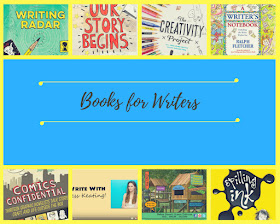We have a basket of books in the classroom library that is rarely used. This is a basket of books for writers--books to help writers in some way. The books are fantastic and I've never thought about them as nonfiction but I realize most of them do fall under the category of nonfiction. Most of the books in the basket serve to help writers try something different.
I tend to buy lots of these because I find short texts are perfect for minilesson and small group work. I often use excerpts from these books in mini lessons or with small groups. But it is very seldom that a child chooses to go to one of these books on his/her own.
I realize I haven't done enough to teach students how and when to use these books. There are so many ways people enter books like this and I think a few mini lessons book talking these books, sharing ways to dip into the books, reading some parts aloud, etc. may make these more accessible for students. I also hadn't thought about helping kids see how online resources from some authors do similar things and that writing workshop might be the time you read/view this type of text. Creating a multimedia text set for writers seems important for the coming year.
One thing that I am learning already is that there are so many kinds of nonfiction--far more than any one list can cover. I had never really thought about these as specifically nonfiction but I think the definitely fall into that category (or at least parts of each one do) and my role is to help make them more accessible to writers in the classroom.
At last week's Scholastic Reading Summit in Denver, Stephanie Harvey reminded us to "Look across the curriculum and make sure reading is embedded in every part of the day." We definitely read during writing workshop but I am not sure we read the kind of nonfiction that would help us as writers during that time. I am thinking I need a shelf of books for writers-something a little separate--even though all books can serve as mentors to writers, those books written specifically for writers may need their own more accessible space this year as I think about inviting more nonfiction reading.
Books in this basket currently include:
Writing Radar: Using Your Journal to Snoop Out and Craft Great Stories by Jack Gantos
Our Story Begins: Your Favorite Authors and Illustrators Share Fun, Inspiring and Occasional Ridiculous Things They Wrote as Kids
The Creativity Project: An Awesometastic Story Collection by Colby Sharp
A Writer's Notebook, How Writers Work, Live Writing, and Poetry Matters by Ralph Fletcher
Spilling Ink: A Young Writer's Handbook by Ellen Potter and Anne Mazer
Writing Magic: Creating Stories that Fly by Gail Carson Levine
Comics Confidential: Thirteen Graphic Novelists Talk Story, Craft and Life Outside the Box by Leonard S. Marcus
Online Resources to be Included in This Text Set
Melissa Stewart's Site-Revision Timelines as well as her Behind the Books posts on her blog
Write with Jess Keating: Write with Jess Keating Series--10 videos


A books for writers basket!!! I'm all in. What a terrific idea. In the meantime, I'm going to go back and read a few of these again. Thanks for the thinking.
ReplyDelete